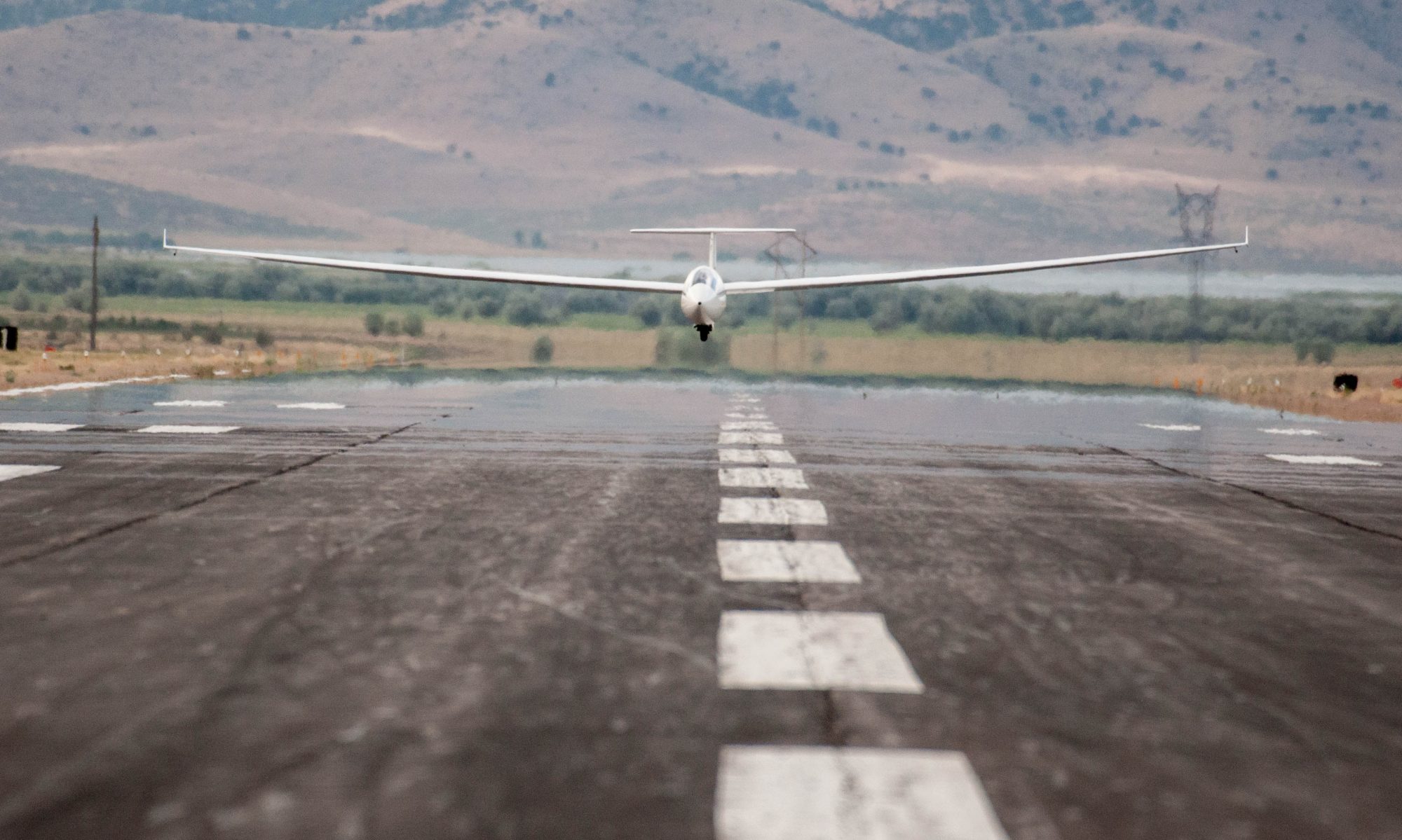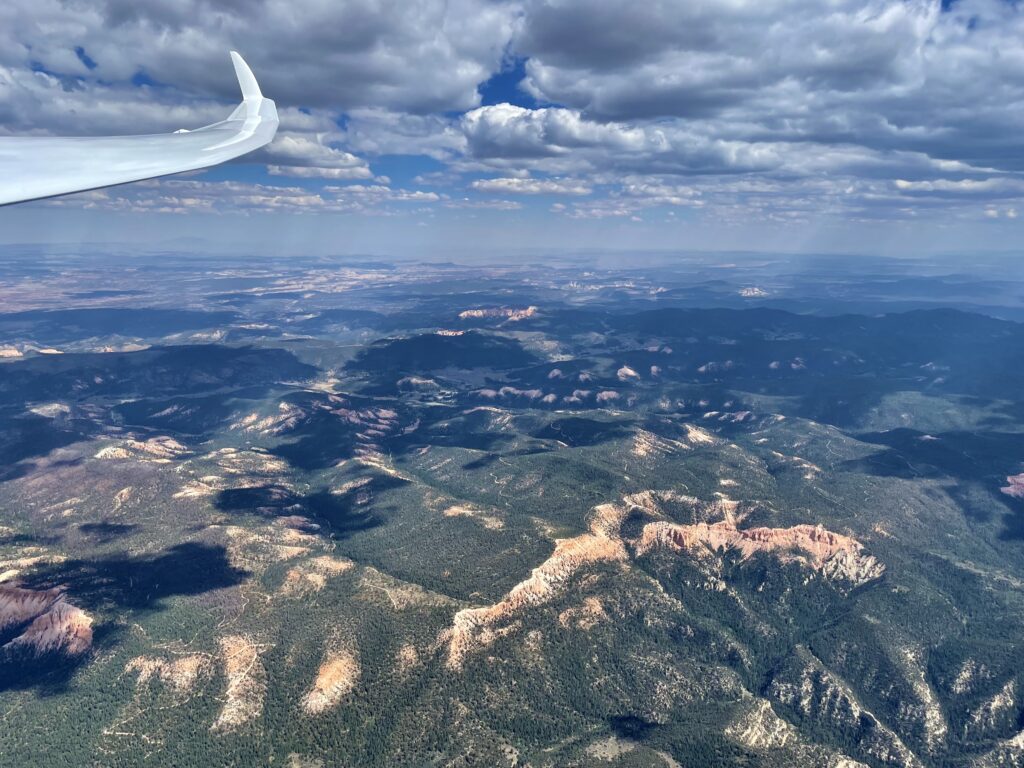Yesterday late afternoon, on our rest day, someone must have flipped a switch because suddenly the power was out. Not just in Nephi but in the whole area. It stayed out all night and only came back after the sun had come out and was warming the ground.
Today, Day 6 of the 18m Nationals, was just like that. We were given a big assigned racing task to fly. More than 600 kilometers with small 500m FAI turn cylinders at Monroe Peak, Bryce Woodlands, Griffin Top, Browns Peak, and Big Baldy. Then back to Nephi.
Conditions were forecast to be strong. However, a northerly wind was blowing even in the morning bringing relatively cool air from Utah Lake and the Great Salt Lake to the launch area. (I say relatively because it was still quite hot.) This depressed thermal activity at the start and it took quite a while to get the fleet launched. And even then, thermals near the start were weak and topped out at about 13,000 feet.
When the gate opened everyone had to descend to 12,000 feet and then almost the entire fleet was flying in a single gaggle near the start line trying to get up but it wasn’t really working. We were just going in circles without gaining much altitude. It was already very late for our big task – almost 3PM – and I got impatient and went out on course. Since I am not one of the fast guys no-one gets on my heels which is just fine with me…
Three weeks of contest flying haven’t made me a gaggle person and I enjoy making my own decisions even though I know it’s usually not the fastest way to get around the course.
I crossed the valley to the east to join the clouds over the San Pitch Mountains, found a good climb at the south end, and then back west to the Pavani Range. Some others had gone direct through the blue – I don’t know if that made them faster. There was great lift just east of the Fire TFR, and from there I crossed to Monroe Peak, which worked well as usual. From there I followed the western edge of the Sevier Plateau in good air to the southern-most turnpoint.
The next leg took us over the Bryce Canyon area where I blundered by taking a too far northerly line which led into a heavy sink street. I deviated back to the south, more than 90 degrees off course to get into better air at the southern tip of the Escalante Mountains. The sink street and deviation cost me at least 10-15 minutes, which I really came to regret later. The entire area is quite spectacular. I previously knew it only at level ground from hiking and trail running trips to the National Parks at Bryce Canyon and Grand Staircase Escalante.
The western drop off of the Escalante Mountains produced an extremely powerful lift line and soon I was running again at 120 kts to the north. The Griffin Top turnpoint was perfectly aligned with the lift line and no stopping was needed anywhere. There was a blue hole to cross west of Wayne Wonderland but the convergence line extended through the blue, marked by some whispies along the way. Near Whiskey Knoll I got onto the Wasatch Plateau and the usual convergence on the plateau worked very well. Some pilots flew a bit further east and I was able to pass them along the western edge of the clouds. The convergence training in Boulder served me well locating the line of lift along the clouds.
Near Knob Mountain the convergence line curved strongly to the east and I had to get to Browns Peak, on the northwest side of the plateau. I decided to leave the wonderful line of clouds and fly the remaining 50km to the turnpoint in the blue along the western edge of the plateau. The air was reasonably good such that I achieved about a 50:1 glide ratio at about 80 kts. But as soon as I had left the clouds the convection shut down and thermal activity became minimal.
I turned Browns Peak about 2000 feet below final glide with another 100km to go to the finish. My flight computer showed some predicted convergence zones over the high terrain southwest of Mount Nebo and along the western edge of the San Pitch Mountains. I decided to detour to their western side and I was quite confident that I would be able to pick up the remaining 2000 feet along the way.
However, just like the day before, it was late afternoon and someone must have switched off the power. I followed the best looking terrain that had been in the sun all day long but there was simply no climb to be found. I worked my way south along the ridges towards the last turnpoint at Mount Baldy. Eyeballing it I wasn’t sure if I would be able to get there above the peak. It would be close.
I carefully examined the slope of the canyons to the west to ensure that I had a safe escape route into the valley and decided it was ok to give it a try. Fortunately the 500m turn radius was big enough to allow me to turn before the actual mountain for I did not have enough altitude to fly over the top.
Now back to Nephi. I was now 200 feet below final glide at MC0 and needed to find just one climb to make it back above minimum finish altitude.
The closer I got to Nephi the stronger the headwind became and the gap gradually became bigger. The north facing ridge lines worked just a little bit and I followed them religiously wherever I could to eke out a few feet of altitude gain. There was absolutely nothing to circle in and I don’t think that ridge soaring figure eights would have worked either. The little bit of lift was too close to the rocks and just too weak.
I knew there were some good hay fields south of the airport in case I did not make it back home so I kept going. 10km out it was evident that I would make the airport but that there was no way to finish above the 6500 ft minimum arrival altitude.
I monitored the radio for quite some time and fortunately no-one else was coming back at the same time. I eventually crossed the finish line at 5600 feet and decided to land straight in from the south on Runway 35. The landing was nice and smooth but I was clearly too low for a valid finish.
The 10-15 minutes that I wasted near Bryce Canyon airport made all the difference because the lift had ended just as abruptly as the power outage arrived the day before.
I’m a bit puzzled why the lift can end so abruptly. In Boulder it is almost always possible to find lift late in the day and I also had some great evening runs in lift along the San Pitch Mountains where the air was just dead today. I suspect it may have to do with the northerly wind that also messed up our start. Once the sun starts to go down, the north wind strengthens and brings more and more cool air into the valley. This then results in a fairly abrupt end of thermal activity. The problem on final glide from the south is compounded by the fact that the strengthening headwind is not anticipated by the flight computer which therefore delivers overly optimistic readings. That’s worth considering for the remaining two days.
What could I have done differently? Well, those who stuck together as a group had a better chance to find the last climb of the day in the blue. They may also have had a better chance of avoiding the sink street that cost me the crucial 10-15 minutes at the end. Maybe I need to learn to love gaggle flying and become a part of the herd… I don’t know. Something to contemplate.
Andy Blackburn won the day today ahead of Rick Indrebo and John Seaborn. Sean Fidler leads overall ahead of Rick Indrebo, Andy Blackburn, Jim Lee, and John Seaborn. The top 5 are less than 200 points apart.
Flight Trace on WeGlide: https://www.weglide.org/flight/81731
Flight Trace on OLC: https://www.onlinecontest.org/…/gliding/flightinfo.html…
Contest Results: https://members.ssa.org/ContestResults.asp?contestId=2486&ContestDetailId=24445&ContestName=2021+18%2DMeter+Nationals+at+Nephi&ContestDate=7/6/2021&ResultsUpdate=True



fbz90x
rthsll
8r3w2i
8xxru9